Through Qualified Charitable Distributions, Donors Can Make Large Gifts for Immediate Impact.
The Abarca family has a long history of both entrepreneurship and philanthropy going back several generations in Denver. When the family decided to focus its giving on community-informed healthcare, they partnered with The Denver Foundation to establish a designated fund that provides ongoing support to Tepeyac Community Health Center (formerly La Clinica Tepeyac). Located in the Globeville-Elyria-Swansea neighborhood, the organization provides culturally informed health care (including medical, dental, and behavioral-health services) to underserved community members.
“Providing strong health services to our community is important to us as a family,” says Adrianna Abarca, whose parents, Luis and Martha, created the fund. “We wanted to create an ongoing income stream for this important community service resource.”

The Abarcas fund was opened and built with Qualified Charitable Distributions (QCDs), an increasingly popular and flexible tool for driving impact.
Also called “IRA charitable distributions” or “IRA charitable rollovers,” QCDs allow those 70½ years old or older to donate up to $100,000 directly from retirement plans or taxable IRA instead of taking their required minimum distributions (RMDs).
“A QCD is a superb strategy for saving taxes on a distribution from your retirement plan or that of your client,” says L. William Schmidt, Jr., Fellow, American College of Trust and Estate Council, and Chair Emeritus of the Foundation’s Professional Advisors Council. “There is no guarantee that this strategy will continue to exist in future years, so now is the time to consult your tax saving toolkit and determine if you may benefit from this opportunity.”
How QCDs Work
People who hold Individual Retirement Accounts (IRAs) are required to take RMDs each year beginning at age 72, even if they don’t need or want the funds. That same RMD increases the IRA holder’s total taxable income. However, the IRA Charitable Rollover, made permanent in 2015, allows individuals aged 70½ or older to transfer up to $100,000 annually from their IRA accounts directly to nonprofit organizations without first having to recognize the distribution as income. Each spouse in a married couple can make QCDs up to the $100,000 limit, for a potential total of $200,000.
QCDs can be divided between multiple organizations as long as the sum of the distributions is under $100,000. A donor can make one large contribution or several smaller contributions over the course of the calendar year.
QCDs at The Denver Foundation
Donors may use QCDs to support a variety of funds at The Denver Foundation, such as designated funds, field of interest funds, and scholarships. Annually, the Foundation receives QCD support in amounts ranging from $500 to $45,000 for The Critical Needs Fund and The Fund for Denver. Many donors have established funds, including scholarships and endowed funds, for specific purposes.
Patricia McClearn, for example, uses her QCD to build the Patricia B. McClearn Education Fund and the Patricia B. McClearn Fund for Early Childhood Education.
“Using my IRA to build these funds allows me to increase my charitable giving without incurring taxable activity for me,” says Patricia. “I want The Denver Foundation to have as much support as possible for education grantmaking, both today and in the future.”
What organizations qualify to receive QCDs?
To receive QCDs, nonprofits must be 501(c)(3) organizations, eligible to receive tax-deductible contributions. Importantly, some organizations do not qualify for QCDs, including private foundations and supporting organizations. QCDs may not be distributed to donor-advised funds.
State tax rules on QCDs vary, so donors using charitable distributions should consult their tax advisor to understand the impact on state tax liabilities.
Does a QCD make sense for my clients?
A QCD can provide several important benefits. It may be a suitable giving strategy for donors who:
- are required to take a minimum distribution from an IRA, but don’t need the income.
- would like to reduce the balance in an IRA account to lower future required minimum distributions.
- would like to make a larger charitable gift than they could if they simply donated cash or other assets. The value of charitable gifts that can be deducted from a tax return usually ranges from 20% to 60% of the donor’s adjusted gross income. This AGI-based limit does not apply to QCDs, allowing donors to make larger gifts.
- have an existing relationship with a nonprofit organization or a clearly defined giving plan that they want to support immediately with a substantial gift.
To learn more about how a Qualified Charitable Distribution can help your clients meet their philanthropic goals, please contact Rachel Spory-Leek, Planned Giving Officer, at rsleek@denverfoundation.org, or 303.300.1790.
Visit The Denver Foundation’s website, where you’ll find resources related to QCDs, including a sample letter that can be customized and sent to a plan provider to initiate the rollover process. Please contact us when a rollover has been directed so that we can watch for a gift’s arrival.
Recommended reading: Qualified Charitable Contributions: The Best Way To Make Charitable Gifts After Age 70½
